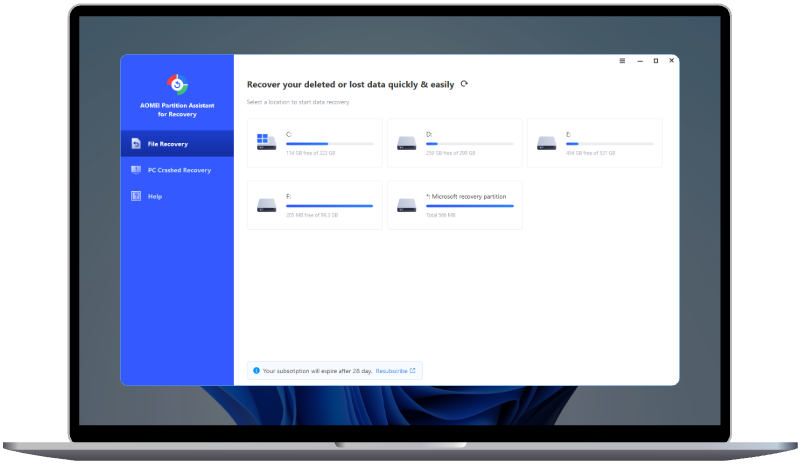Top 3 Ways to Data and File Recovery in Windows PCs
Data and file loss may be a frustrating thing for most people, but don’t worry. In this post, you will learn the most possible reasons and three effective solutions to data and file recovery.
Common causes to data and file loss
Data and file loss can occur for various reasons, some of which are avoidable, while others are not. Understanding the common causes can help in preventing such issues and ensuring data safety. Here are some of the primary culprits:
1. Accidental deletion
Accidentally deleting files is one of the most common reasons for data loss. Whether it's from hitting the wrong button, misplacing a file, or mistakenly removing an important document, human error is a significant factor.
2. Hard drive failure
Mechanical or physical failure of a hard drive is a frequent cause of data loss. This can occur due to aging components, wear and tear, or sudden impacts like dropping a laptop. Hard drives are vulnerable to overheating and electrical surges as well.
3. File system damage
File systems, which organize and store data on storage devices, can become damaged due to improper shutdowns, software malfunctions, or hardware issues. Damage to the file system may make files unreadable or cause them to disappear entirely.
4. Accidental formatting
Sometimes, users format a storage device by mistake. While this process removes all files from the device, it's often a case of user confusion or error during disk management or partitioning.
5. Insufficient storage space
Running low on disk space can lead to files not saving correctly or being corrupted in the process. Insufficient storage can also cause performance issues that ultimately result in lost data.
Is it possible for data and file recovery?
Yes, data and file recovery is possible in many cases. When files are lost due to accidental deletion, formatting, or corruption, specialized tools and techniques can often retrieve the data. However, the success of recovery depends on several factors, such as the type of storage device, the extent of the damage, and how much new data has been written over the lost files. For example, if a hard drive fails due to physical damage, recovery might be more challenging.
In contrast, for logical errors, such as file system corruption or accidental deletion, recovery is often more feasible. The sooner the recovery process is initiated, the higher the chances of successful data retrieval, as continued use of the device can overwrite the lost data.
How to perform data and file recovery on Windows PCs
Accidentally losing important files can be a frustrating experience, but the good news is that Windows PCs offer several recovery options. Whether you deleted a file by mistake, or something went wrong with your system, these methods can help you retrieve lost data. Let’s explore the top three methods for file recovery in Windows.
Method 1. Using the Recycle Bin
The first line of defense when you accidentally delete a file is the Recycle Bin. When you delete files in Windows, they’re not permanently gone right away. Instead, they are moved to the Recycle Bin, where you can restore them.
Step 1. Double-click the Recycle Bin icon on your desktop.
Step 2. Browse through the files, or use the search bar to find the specific file.
Step 3. Right-click the file you want to recover and select Restore. The file will be restored to its original location.
If you’ve emptied the Recycle Bin or the file is not there, don’t worry; there are other methods to explore.
Method 2. From File History
Windows also has a built-in feature called File History, which periodically backs up files to an external drive or network location. If you've enabled File History, it can help you recover older versions of your files.
Step 1. Go to Control Panel > System and Security and click File History.
Step 2. Select Restore personal files. It will open the file history recovery window.
Step 3. Click the left arrow to locate your deleted files, and click the Restore to original location icon to restore deleted files from Recycle Bin.
If you haven’t set up File History yet, this option won’t work for you, but don’t panic. You can still use third-party recovery software to retrieve your lost files.
Method 3. With third-party data recovery software
When the Recycle Bin is emptied or File History is unavailable, third-party data recovery tools are your next best option. AOMEI Partition Assistant for Recovery is a professional-grade data recovery tool designed to retrieve lost or deleted files from hard drives, SSDs, USB flash drives, SD cards, and other storage devices. It caters to individual users and professionals who need a dependable and fast solution to restore data in different scenarios.
Key features of AOMEI Partition Assistant for Recovery
✯ User-friendly interface: With its intuitive design, AOMEI Partition Assistant for Recovery simplifies the data recovery process for users, regardless of technical expertise. The step-by-step guide ensures you can retrieve your files without hassle.
✯ Supports multiple file types: Whether you’ve lost photos, videos, documents, or emails, AOMEI Partition Assistant for Recovery can recover a wide range of file formats, making it suitable for all kinds of data recovery needs.
✯ Advanced scanning modes: Quick Scanlocates recently deleted files for rapid recovery. Deep thoroughly examines your storage device to recover lost files even in complex situations.
✯ High recovery success rate: Built with advanced algorithms, AOMEI Partition Assistant for Recovery boasts a high success rate for recovering files from damaged hard drive, or formatted/dead storage media.
✯ Preview feature: Before recovery, you can preview the found files, ensuring you only restore what you truly need.
Safe and secure: AOMEI Partition Assistant for Recovery ensures data integrity during the recovery process. It operates in a read-only mode, meaning your original data won’t be overwritten or damaged.
Step 1. Install and launch AOMEI Partition Assistant for Recovery. Choose the exact partition or disk where your data lost and click Scan.
Step 2. Then, the recovery tool start to scan and search. lt will execute the “Quickly Scan" first for finding your deleted data fast, and then execute the “Deep Scan" for searching other lost data.
Step 3. Once the scan is completed, all deleted files, recycle bins and other missing files will be displayed. Please select the file you would like to recover and then click "Recover".
Step 4. Then, select a folder path to save your recovered files.
Step 5. Wait patiently for this process of recovery to end.
Conclusion
Data and file loss is an issue that can happen to anyone, often due to accidental deletion, hardware failure, or system corruption. While these situations can be frustrating, recovery is often possible with the right methods like Recycle Bin or File History. If those methods don’t work, third-party recovery software can provide a solid solution. Remember to regularly back up your data to avoid future loss.

